Related Research Articles

Starfish or sea stars are star-shaped echinoderms belonging to the class Asteroidea. Common usage frequently finds these names being also applied to ophiuroids, which are correctly referred to as brittle stars or basket stars. Starfish are also known as asteroids due to being in the class Asteroidea. About 1,900 species of starfish live on the seabed in all the world's oceans, from warm, tropical zones to frigid, polar regions. They are found from the intertidal zone down to abyssal depths, at 6,000 m (20,000 ft) below the surface.
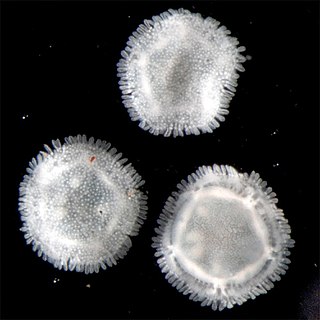
Sea daisies make up an unusual group of deep-sea taxa belonging to the phylum Echinodermata, with three species described in the genus Xyloplax. Intestine and anus are absent.
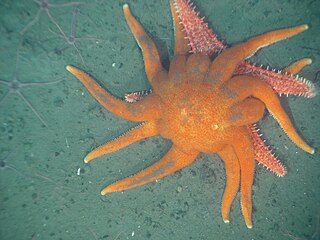
The Valvatida are an order of starfish in the class Asteroidea, which contains 695 species in 172 genera in 17 families.

The Echinasteridae are a family of starfish in the monotypic order Spinulosida. The family includes eight genera and about 133 species found on the seabed in various habitats around the world.

The Asterinidae are a large family of sea stars in the order Valvatida.
Papulae, also known as dermal branchiae or skin gills, are projections of the coelom of Asteroidea that serve in respiration and waste removal. Papulae are soft, covered externally with the epidermis, and lined internally with peritoneum. They extend through the mesodermal ossicles and are protected from microscopic larvae by pedicellariae. In a living specimen, the dermal gills can be extended or withdraw.
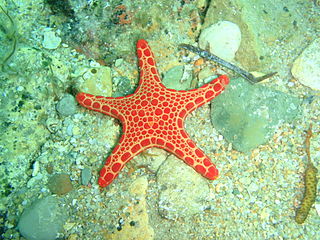
Goniasteridae constitute the largest family of sea stars, included in the order Valvatida. They are mostly deep-dwelling species, but the family also include several colorful shallow tropical species.
Ambulacral is a term typically used in the context of anatomical parts of the phylum Echinodermata or class Asteroidea and Edrioasteroidea. Echinoderms can have ambulacral parts that include ossicles, plates, spines, and suckers. For example, sea stars or "star fish" have an ambulacral groove on their oral side (underside). This ambulacral groove extends from the mouth to the end of each ray or arm. Each groove of each arm in turn has four rows of hollow tube feet that can be extended or withdrawn. Opposite the ambulacral groove is an ambulacral ridge on the aboral side of each ray, known as an ambulacrum. These have interambulacra between them.
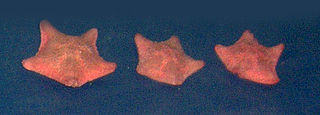
Asterina is a genus of asteroideans in the family Asterinidae.

The Forcipulatida are an order of sea stars, containing three families and 49 genera.
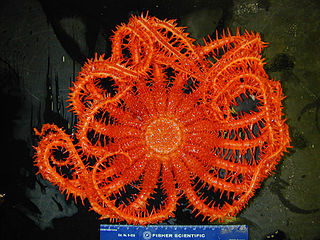
The Brisingids are deep-sea-dwelling starfish in the order Brisingida.

The Asterozoa are a subphylum in the phylum Echinodermata. Characteristics include a star-shaped body and radially divergent axes of symmetry. The subphylum includes the class Asteroidea, the class Ophiuroidea, and the extinct order Somasteroidea.
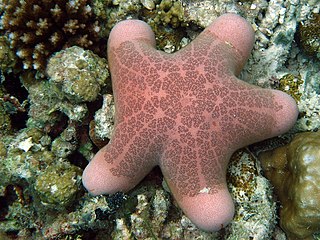
The Oreasteridae are a family of sea stars in the class Asteroidea.

Protoreaster is a genus of sea stars in the family Oreasteridae from the Indo-Pacific. They are sometimes seen in the marine aquarium trade.
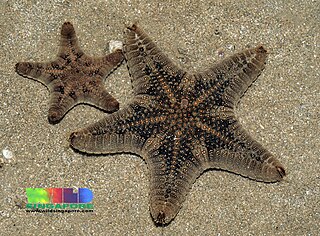
Goniodiscaster is a genus of sea stars in the family Oreasteridae.

The Porcellanasteridae are a family of sea stars in the order Paxillosida. These sea stars are found at abyssal depths. The World Asteroidea Database includes these genera in this family:

The Zoroasteridae are one of three families of Asteroidea in the order Forcipulatida. It contains seven living genera and one extinct genus.

Heliaster is a genus of Asteroidea in the family Heliasteridae.
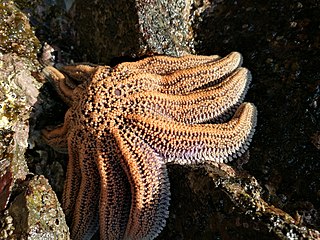
The Stichasteridae are a small family of Asteroidea in the order Forcipulatida. Genera were formerly unassigned, or in the family Asteriidae.
Maureen Elizabeth Downey was an American zoologist who worked for three decades at the Smithsonian National Museum of Natural History. Known as "The Starfish Lady," she was an authority on sea stars and other echinoderms, co-founding the International Echinoderm Conference in 1972. Among her discoveries is Midgardia xandaros, the world's largest starfish.
References
- 1 2 3 C.L. Mah (2010). "Asteroidea taxon details for Acheronaster H.E.S.Clark, 1982". World Asteroidea Database. Retrieved June 29, 2011.
